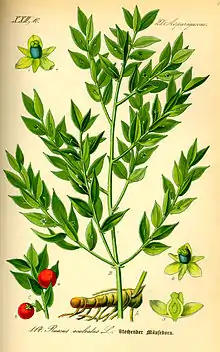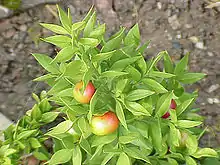Ruscus aculeatus
Ruscus aculeatus, known as butcher's-broom,[2] is a low evergreen Eurasian shrub, with flat shoots known as cladodes that give the appearance of stiff, spine-tipped leaves. Small greenish flowers appear in spring, and are borne singly in the centre of the cladodes. The female flowers are followed by a red berry, and the seeds are bird-distributed, but the plant also spreads vegetatively by means of rhizomes. It is native to Eurasia and some northern parts of Africa.[3] Ruscus aculeatus occurs in woodlands and hedgerows, where it is tolerant of deep shade, and also on coastal cliffs. Likely due to its attractive winter/spring color, Ruscus aculeatus has become a fairly common landscape plant.[3] It is also widely planted in gardens, and has spread as a garden escapee in many areas outside its native range. The plant grows well in zones 7 to 9 on the USDA hardiness zone map.[3]
| Butcher's-broom | |
|---|---|
 | |
| Scientific classification | |
| Kingdom: | Plantae |
| Clade: | Tracheophytes |
| Clade: | Angiosperms |
| Clade: | Monocots |
| Order: | Asparagales |
| Family: | Asparagaceae |
| Subfamily: | Nolinoideae |
| Genus: | Ruscus |
| Species: | R. aculeatus |
| Binomial name | |
| Ruscus aculeatus | |
| Synonyms[1] | |
| |
The Latin specific epithet aculateus means “prickly”.[4]

History
Etymology
The common name, butcher's broom, hails from one of its original uses. In Europe, Ruscus species were traditionally harvested for their flat and stiff branches to make small brooms that were used for clearing off and cleaning butchering blocks.[5] Recent research has uncovered that butcher's broom contains some antibacterial compounds.[5] This suggests that in addition to the functional physical properties of Ruscus species, increased effectiveness in cleaning and producing safer products due to unrecognized antibacterial oils may have contributed to its popularity and subsequent nickname.
Traditional medicinal usage
Butcher's broom has been used by a variety of peoples as a treatment for a variety of ailments. A classical remedy from Europe claimed that the rhizomes could be used as a diuretic.[5] In ancient Greece, butcher's broom was used as a laxative or diuretic, and it was also believed to remove kidney stones when added to wine.[6] Butcher's broom was also used to reduce swelling and to speed the recovery of fractures.[7]
Phytochemicals
The major phytochemicals in butcher's broom are steroidal saponins.[8] Saponins occur naturally in plants as glycosides and have foam forming properties.[9] The specific saponins found in butcher's broom are ruscogenins, ruscogenen and neoruscogenin, named for the genus Ruscus.[5] Ruscogenins function as anti-inflammatory agents[10] and are also believed to cause constriction in veins.[11] Currently the mode of action of ruscogenins is not well understood, but one proposed mechanism suggests that ruscogenins suppresses leukocyte migration through both protein and mRNA regulation.[10]
Newer research has also uncovered that there are polyphenols present in butcher's broom may also be physiologically active, possibly as an antioxidant.[12][13] As of yet there is not enough evidence to make a conclusion, but since they have now been synthesized in labs further research should be in progress.

Cultivars
The dwarf cultivar ‘John Redmond’, growing to 50 cm (20 in) tall by 100 cm (39 in) broad, has gained the Royal Horticultural Society’s Award of Garden Merit.[14][15]
Other cultivars include 'Christmas Berry'.[16]
References
| Wikimedia Commons has media related to Ruscus aculeatus. |
| Wikispecies has information related to Ruscus aculeatus. |
- The Plant List: A Working List of All Plant Species, retrieved 5 August 2017
- "BSBI List 2007". Botanical Society of Britain and Ireland. Archived from the original (xls) on 2014-10-23. Retrieved 2014-10-17.
- "Ruscus aculeatus - Plant Finder". www.missouribotanicalgarden.org. Retrieved 2018-11-28.
- Harrison, Lorraine (2012). RHS Latin for Gardeners. United Kingdom: Mitchell Beazley. ISBN 978-1845337315.
- "HerbalGram: Butcher's Broom". cms.herbalgram.org. Retrieved 2018-11-28.
- Abascal, Kathy; Yarnell, Eric (June 2002). "Butcher's Broom: Herb's Potentials Too-Often Swept Under the Rug". Alternative and Complementary Therapies. 8 (3): 177–185. doi:10.1089/107628002760091038. ISSN 1076-2809.
- "Butcher's Broom Effectiveness, Safety, and Drug Interactions on RxList". RxList. Retrieved 2018-11-28.
- Jakobsson, Hugo; Farmaki, Katerina; Sakinis, Augustinas; Ehn, Olof; Johannsson, Gudmundur; Ragnarsson, Oskar (2018-05-15). "Adrenal venous sampling: the learning curve of a single interventionalist with 282 consecutive procedures". Diagnostic and Interventional Radiology. 24 (2): 89–93. doi:10.5152/dir.2018.17397. ISSN 1305-3612. PMC 5873508. PMID 29467114.
- Sahu, N. P.; Banerjee, S.; Mondal, N. B.; Mandal, D. (2008), "Steroidal Saponins", Fortschritte der Chemie organischer Naturstoffe / Progress in the Chemistry of Organic Natural Products, Springer Vienna, pp. 45–141, doi:10.1007/978-3-211-74019-4_2, ISBN 9783211740187
- Huang, Ya-Lin; Kou, Jun-Ping; Ma, Li; Song, Jia-Xi; Yu, Bo-Yang (October 2008). "Possible mechanism of the anti-inflammatory activity of ruscogenin: role of intercellular adhesion molecule-1 and nuclear factor-kappaB". Journal of Pharmacological Sciences. 108 (2): 198–205. ISSN 1347-8613. PMID 18946195.
- Bouskela, Eliete; Cyrino, Fatima Z. G. A.; Marcelon, Gilbert (August 1993). "Effects of Ruscus Extract on the Internal Diameter of Arterioles and Venules of the Hamster Cheek Pouch Microcirculation". Journal of Cardiovascular Pharmacology. 22 (2): 221–224. doi:10.1097/00005344-199308000-00008. ISSN 0160-2446.
- Herrmann, Josef M.; Untergehrer, Monika; Jürgenliemk, Guido; Heilmann, Jörg; König, Burkhard (2014-04-08). "Synthesis of Phenyl-1-benzoxepinols Isolated from Butcher's Broom and Analogous Benzoxepines". European Journal of Organic Chemistry. 2014 (15): 3170–3181. doi:10.1002/ejoc.201400004. ISSN 1434-193X.
- Barbič, Matej; Schmidt, Thomas J.; Jürgenliemk, Guido (June 2012). "Novel Phenyl-1-benzoxepinols from Butcher's Broom (Rusci rhizoma)". Chemistry & Biodiversity. 9 (6): 1077–1083. doi:10.1002/cbdv.201100158. ISSN 1612-1872. PMID 22700226.
- "RHS Plantfinder - Ruscus aculeatus 'John Redmond'". Retrieved 11 October 2018.
- "AGM Plants - Ornamental" (PDF). Royal Horticultural Society. July 2017. p. 93. Retrieved 11 October 2018.
- Gys Petrus de Jong, Ruscus plant named 'Christmas Berry' US PP16680 P2, retrieved 20 July 2016
External links
- botanical.com: A Modern Herbal, Broom, Butcher's
- nutrasanus.com: NutraSanus, Butcher's Broom Benefits and Information